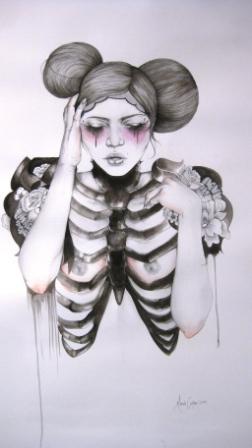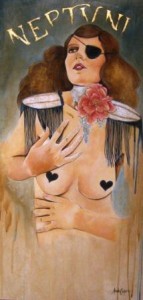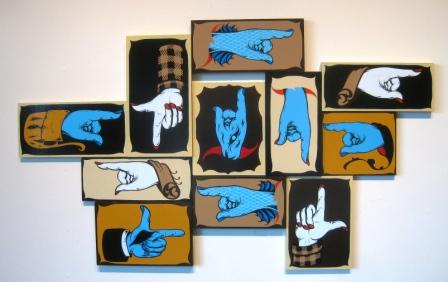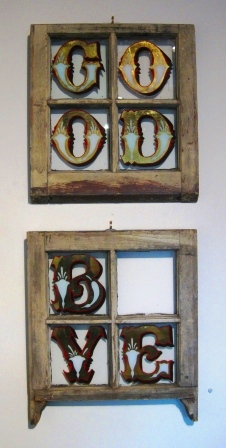This Isle’s Loss
December 30th, 2010This article originally appeared on December 30, 2010 in The Island. Michele Ellson, editor. Reprinted with additional images.

Renee Castro, "La Llorona," watercolor, ink, and graphite on paper, 2010.
If you’re naughty, La Llorona will get you!
The Weeping Woman of Hispanic folklore is a bad, bad woman. Specifically, she was a failed wife and mother. Tsk, tsk. Like the teenage girls of slasher flicks, she is a cautionary tale, punished for expressing her sexual desires, and doomed to walk the earth in the fruitless search for her children.
Renee Castro depicts her not as a monster, but as a beautiful, forlorn, sensual woman. Yet she is corseted by her exoskeleton, suggesting not only her undead state but that what was inside her has emerged and enslaved her, upping the ante on the metaphor of wearing one’s heart on their sleeve.
Castro has exhibited previously at Autobody Fine Art, as has Ken Davis, and together their work celebrates and reinterprets Alameda’s long defunct Neptune Beach Amusement Park in the gallery’s “The Lost Isle of Neptune” – Autobody’s final exhibit – which is open through January 28, 2011.
La Llorona could be the patron saint of Castro’s women, who all defy convention. They are aviators, circus ringmasters, and wrestlers, participants in male-dominated professions. Although the artist describes them as “not overly sexual,” they are also dripping with sexuality (and paint) and are, with few exceptions, bare breasted.

Renee Castro, "Neptvni," acrylic, ink, and graphite on paper, 2010.
Castro explains that this is inspired by her Ohlone Indian ancestry. Like many of her characters, only the women were adorned with tattoos, and they were bare breasted. She says, “In our tribe men would hunt, but women were strong.” As for the topless professionals in her paintings she says, “They are still strong, but also female. You can’t hide behind a uniform.”
She reworks familiar motifs and images and gives them a modern spin. “Neptvni” is a female version of Neptune, inspired by the Imperium Neptuni Regis certificate awarded to her father when he crossed the equator in the Navy. And several of her characters, be they sea creature or conjoined twins, wear Mickey Mouse ears. This was suggested by the shape of the double bun hairstyle in paintings like “La Llorona,” as well as the hats worn by matadors. These two elements support the aquatic amusement park theme quite nicely.
Ken Davis is a man who doesn’t need to stop to ask directions; His signs point the way, although where you’ll end up is anybody’s guess.

Ken Davis, Hands, 1 Shot enamel on wood, 2010.
Davis creates his signage with 1 Shot enamel and gold leaf on glass, wood, and metal, all traditional materials. Some bear text bidding a fond farewell to a bygone era, reading, “Wild Times” and “Good Bye.” Others are more modern with pithy sound bites: “The Heads Will Roll,” and “Ride or Die.” Davis has one foot in the past, and the other on a skateboard. His artwork is featured in the January 2011 issue of the preeminent skate magazine Thrasher.
His “Rusted Through” best captures the exhibit’s partial, temporary resurrection of Neptune Beach, with its gorgeous lettering on glass framed by wood in disrepair.

Ken Davis, Goodbye, 1 Shot and gold leaf on glass, 2010.
Autobody is about to go the way of Neptune Beach. This is the final exhibit at a gallery that survived nearly three years in the Great Recession under the guidance of Executive Director Jacqueline Cooper and her partner Colin Herrick, along with their fearless (and sometimes paid) gallery manager and CFO, Amy George. According to Cooper, the space will be converted into individual artist studios which she will manage.
There are perhaps a dozen galleries and non-traditional art venues left in Alameda. But Autobody was different, and did more than fill a niche. As a commercial gallery it unapologetically sought the best art it could find, featuring established artists and discovering some new ones. Still, they exhibited some truly “out there” work because it was cool, regardless of its marketability. They managed a nearly seamless integration of “street” and “fine” art. And Autobody was the only gallery in Alameda where full male and female nudity were welcomed, be it in paint, photograph, or live performance.
Receptions were packed, art was sold, and this year Autobody was invited to Aqua Art Miami. But despite these successes, going non-profit, membership drives, dinner parties, and lobbying, their doors are closing. What would it have taken to keep them open?
Autobody lent a degree of legitimacy to the art scene in Alameda which will be sorely missed, and difficult to restore.
“The Lost Isle of Neptune” concludes on January 28, 2011. Autobody is located at 1517 Park Street, Alameda, CA 94501. Their hours are noon to 6 p.m. Wednesday through Sunday.

Guess it's time to git
Michael Singman-Aste
Postdiluvian Photo
Tags: Alameda, Autobody Fine Art, Ken Davis, Renee Castro, The Island



[…] patrons’ disposable income, and forcing some galleries out of business. Autobody Fine Art was one of these. In February 2011 they ceased hosting exhibits on a regular basis, and converted much of its space […]